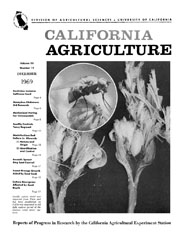


University of California
California Agriculture
|
|||
|
|||

Cover:
Seedfly (photo inset) was imported from Paris and has been established on California rangeland to aid fight against spread of the noxious weed tansy ragwort.
December 1969
Volume 23, Number 12 |
|||
|
University of California, 1301 S. 46th St., Bldg. 478 Richmond, CA
|